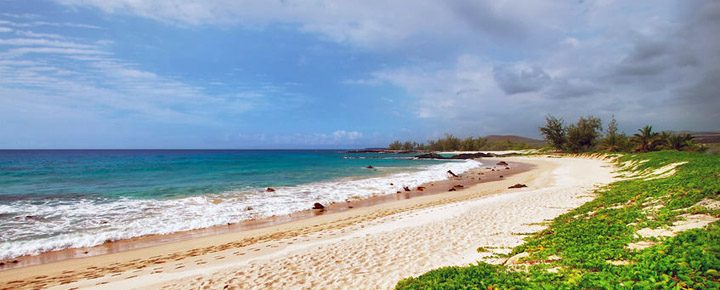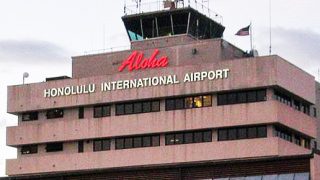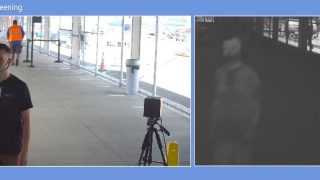When you return to Hawaii, there are some changes you’ll see at airport screenings. Until now, passengers stopped to have their temperature taken by hand-held thermometers. Hereafter, travelers can deplane without needing to stop and will only be contacted as needed, thanks to new equipment and a Safe Travels App.
New Thermal Temperature Screening Coming to a Gate Near You.
The Hawaii Department of Transportation announced this week that “phase two of the new thermal temperature screening equipment installation has been completed at Hawaii’s five airports.” There are 133 cameras in operation that will detect those with a temperature of 100.4 degrees or above.
This temperature scanning equipment is at all gates used for mainland flights.
The next phase is the installation of facial imaging technology which is scheduled to be completed by year’s end to help identify those arriving with an elevated temperature.
Until the facial imaging is available, temperature screenings require that passengers be identified by a specially trained employee, while another employee will speak with the passenger in question. With facial imaging, travelers will be monitored from a central location, thus reducing workforce requirements.
Privacy Concerns Over Facial Imaging.
In terms of privacy concerns, the state said that images are only intended to track those with an elevated temperature, and will be deleted promptly. DOT’s spokesperson said that images “Won’t be kept for more than 30 minutes. It’s not like what you’ve seen in a spy movie. There is no identifying information about who that person is or where they live.”
The technology used for temperature screen and facial scanning will be operated and monitored by the Hawaii National Guard and HDOT.
Those presenting a temperature of 100.4 degrees or higher will receive further evaluation. That will be conducted by AMR paramedics or by the Aircraft Rescue Fire Fighting units stationed at airports. Passengers will be offered a COVID-19 test and the contact information will be provided to the HDOT for contact tracing if needed.
Safe Travels App for Visitors starts September 1.
Starting next week, all Hawaii bound travelers will need to complete an online travel application. The form contains details including origin, destination, accommodation information, and contact details. That can be done in advance. Then, at 24-hours before travel, visitors will complete a health questionnaire detailing any current health issues. This process will be used for both mainland to Hawaii and interisland travel.
A QR code will be sent to the traveler which will then be scanned on arrival at the airport. The app is called Safe Travels, which will be used in conjunction with the above temperature checks as well as additional screening when appropriate.
Hawaii’s governor said the app “Will allow our travelers to provide their required health and travel information before they arrive at the airport. It will also help us keep in contact with those who are required to be in quarantine. This is an important step in preparing to reopen our economy.”
The Safe Travels website is currently in development and more information should be coming soon at https://safetravels.hawaii.gov/.
Get Breaking Hawaii Travel News







Is the health questionaire going to replace the need for a negative test? Thanks,
Hi Fred.
No it is not. More details are pending.
Aloha.
We have a scheduled vacation in Maui this November 1-8. Wrestling with if we should change it until next spring,but then of course, costs are much higher. Thoughts if we will be able to travel there in November without quarantine and lots of restrictions??
Hi Mary, I am not sure when HI is opening, but I do know that the Thanksgiving and Christmas holiday season has historically been a very busy time for HI. I have rebooked a couple of earlier trips in Oct. and Nov. for a longer trip from Dec. 4th – 14th to the BI (I am banking on the resort bubble idea here) and booked Maui for President’s Day Feb. 11th – 16th. I have to see my beautiful whales. If HI is closed in Feb. I can always head North to Monterey or South to San Jose del Cabo to see them. May/June is also a beautiful time in HI. Take a look at Alaska Airlines for non-stops into Maui and BI from San Diego. Aloha!
Thanks for the reply Cheri. We already have the villa and air booked for this November 1. Just wrestling with if we should reschedule to next spring. I know there is no real answer as Hawaii reopening is so unknown. 😢
So once in Hawaii can we go to the beaches and shopping as normal.
MAHALO for the infos.
Waiting for a safe return soon. Web site is very much appreciated. Again MAHALO
Hi Yolanda.
Thank you.
Aloha.
I will be tra ellkng to Maui from Canada lare January 2021. Is a covid 19 test still required. Is there still a quaratine period.
Monday, August 31, 2020
“CDC Admits 94% Not COVID-Only Deaths” by Sierra (NZ) – 8.31.20
What about the 72 hour pretest if coming from the mainland. Any further updates?
Please let me know when the spirit of aloha returns to Hawaii. Until then, it seems they do not welcome guests and we are finding other options. Thanks.
Hi D.F.
Thanks.
Aloha.
I fly in on Sept 1. When will Safe Travels app be available?
Ok,so we need to fill out application and another the night before leaving the mainland as well as being tested 72 hrs prior? What do we do when doing interisland travel in the middle of our vacation?
It is known that most do not have symptoms not even fevers, so a temp
Test will be a waist of time. A covid test should be required before
travelling to Hawaii.
Aloha
Please enforce the covid 19 test prior to arriving to Hawaii. A 72 hour test should be required.
PLEASE!!
Will this still be inclusive of an article I read of wearing bracelets as tourists or and Islanders come in on properties and such also ?
Mahalo
Hi Cowboy B.
Good question. We’ll have to await further clarification on that from the state.
Aloha.
Aloha thanks for the updates keep them coming
My timeshare is do in October hoping to come in March hopefully I don’t have to spend it through two weeks in the the condo property
Mahalo from Seattle Bob
Hi Cowboy B.
Will do. Thanks.
Aloha.
I agree with Mike. Instead of temp tests, which are not reliable, and filling out forms, etc., all they simply have to do is use the new saliva quick tests before flying over. Therefore all that plus quarantining would be unnecessary.
Most scientific sources are skeptical about the benefits of thermal screening. One obvious reason is that many/most people with C-19 don’t have significant fever. Here’s what Science Magazine has to say:
“If you have traveled internationally the past 2 months, you may have encountered them: health officers briefly pointing a thermometer gun at your forehead or watching as you go by to check for signs of a cough or difficulty breathing. Many countries are now watching arriving and departing air passengers who might suffer from the viral disease COVID-19; some require passengers to fill out health declarations. (Some also simply ban or quarantine those who have recently been in outbreak hot spots.)
Exit and entry screening may look reassuring, but experience with other diseases shows it’s exceedingly rare for screeners to detect infected passengers. Just last week, eight passengers who later tested positive for COVID-19 arrived in Shanghai from Italy and passed the airport screeners unnoticed, for example. And even if screeners do find the occasional case, it has almost no impact on the course of an outbreak.
“Ultimately, measures aimed at catching infections in travelers will only delay a local epidemic and not prevent it,” says Ben Cowling, an epidemiologist at the University of Hong Kong. He and others say screening is often instituted to show that a government is taking action, even if the impact is marginal.”